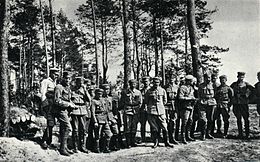Polish Legions in World War I
| Polish Legions in World War I | |
|---|---|
| Legiony Polskie (1914–1918) | |
 Col. Józef Piłsudski with his staff in front of the Governor's Palace in Kielce, 1914
Col. Józef Piłsudski with his staff in front of the Governor's Palace in Kielce, 1914  Col. Józef Piłsudski and his officers, 1915
Col. Józef Piłsudski and his officers, 1915  Pilsudski in Otwock, 1915
Pilsudski in Otwock, 1915  II Brigade of the Polish Legions in Volhynia
II Brigade of the Polish Legions in Volhynia  Europe in 1914, the Central Powers in brown
Europe in 1914, the Central Powers in brown |
| Operations of Polish Legions and the Puławy Legion | |
|---|---|
 |
The Polish Legions (Polish Legiony Polskie) was a name of the Polish military force (the first active Polish army in generations) established in August 1914 in Galicia soon after World War I erupted between the opposing alliances of the Triple Entente on one side (including the British Empire, the French Republic and the Russian Empire); and the Central Powers on the other side, including the German Empire and Austria-Hungary. The Legions became "a founding myth for the creation of modern Poland" in spite of their considerably short existence; they were replaced by the Polish Auxiliary Corps (Polish: Polski Korpus Posiłkowy) formation on 20 September 1916, merged with Polish II Corps in Russia on 19 February 1918 for the Battle of Rarańcza against Austria-Hungary, and disbanded following the military defeat at the Battle of Kaniów in May 1918, against imperial Germany. General Haller escaped to France to form the Polish army in the West against the anti-Polish German-Bolshevik treaty.
The Legions took part in many battles against the forces of the Imperial Russia, both in Galicia and in the Carpathian Mountains. They suffered horrendous casualties outnumbered three to one in the Battle of Łowczówek. They captured Kielce, and in 1915 took part in the offensive on Warsaw. In June 1916 the unit had approximately 25,000 soldiers. Both the number of troops and the composition of units changed rapidly. After the Battle of Kostiuchnówka where 2,000 Polish soldiers died delaying a Russian offensive Józef Piłsudski demanded that the Central Powers issue a guarantee of independence for Poland and partially succeeded. The Polish Legions became the Polish Auxiliary Corps. After the Act of 5th November of 1916 which pronounced the creation of the puppet Kingdom of Poland of 1916–18, the Polish Legions were transferred under German command. However, most of the members refused to swear allegiance to the German Kaiser and were interned in Beniaminów and Szczypiorno (the Oath crisis). Approximately 3,000 of them were drafted into the Austro-Hungarian army and the failed German Polnische Wehrmacht, while approximately 7,500 stayed in the Austrian Polish Auxiliary Corps. They were sent to the Italian Front.
...
Wikipedia
